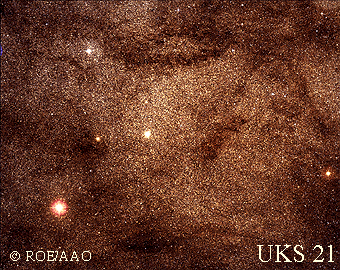Astronomy Picture of the Day
Discover the cosmos! Each day we feature a different image or photograph
of our fascinating universe, along with a brief explanation written by a
professional astronomer.
February 1, 1996

Lensing through Baade's Window
Credit:
Photograph made from plates taken with the
UK Schmidt
Telescope.
Color photography by David Malin.
Copyright:
Anglo-Australian Telescope
Board
Explanation:
What is the shape and composition of our
Milky Way Galaxy? This question
would be easier to answer if there wasn't so much obscuring
dust! In the
1940s, however, astronomer
Walter
Baade identified a "window" near the
center of our Galaxy where there is comparatively little opaque dust. Now
called
"Baade's
Window", this sky region contains millions of stars and is
used for many studies of the distant
Milky Way. One clever use, devised by
Bohdan Paczynski, is to monitor millions of stars in our Galactic Bulge -
many through Baade's window - for
sudden brightening due to
gravitational
lensing. Current observations by the
OGLE and
MACHO
collaborations have now identified dozens of gravitational amplification
events. This unexpectedly large number supports previous claims that
our Galaxy
has a "bar" of stars across the central nucleus, pointed nearly at the
Sun.
Tomorrow's picture: A MACHO View of Galactic Dark Matter
| Archive
| Index
| Glossary
| Education
| About APOD |




Authors & editors:
Robert Nemiroff
(GMU) &
Jerry
Bonnell (USRA).
NASA Technical Rep.:
Sherri
Calvo.
Specific rights apply.
A service of:
LHEA
at
NASA/
GSFC




